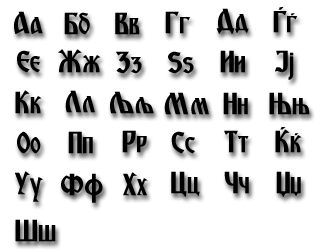Macedonian language
Macedonian language
Language is one of the most important features of a people. As far as the Macedonian people and its state are concerned, language is of extreme significance and offers confirmation of their historical continuity. Apart from being the official language in the Republic of Macedonia, Macedonian language is spoken and cherished in many European countries, the United States, Canada and Australia, wherever Macedonians live. It is also the mother tongue and language of everyday communications in those parts of the Balkan states populated by ethnic Macedonians (like Aegean Macedonia in north Greece, Pirin Macedonia in southwestern Bulgaria, Mala Prespa and Golo Brdo in southeastern Albania and in Serbia). As the official language of the Republic of Macedonia, Macedonian is written using the Cyrillic alphabet. The Macedonian literary standard is a modern European language, which according to its characteristics is different from the neighboring and other Slavic languages.

Macedonian language origin
Macedonian is an Indo-European language from the family Slavic languages belonging to the South Slavic group. At the same time, it is a Balkan language. It is interesting to mention that there are instances in the world when two or more nations have a common language, and vice versa, when some nations have two languages. The Macedonian nation, however, is in this respect like the majority of nations in the world - its members have a separate language. This fact creates a feeling of independence in every member of the Macedonian nation and represents a significant contribution of Macedonian national consciousness.
Macedonian language history
The historical development of the Macedonian language dates back to the 9th century AD when the Slavonic literacy began with a standard Macedonian language. The modern codification of the Macedonian literary language was as late as 1944, although from the 1860s onwards, attempts were made at creating a general Macedonian literary standard. The Macedonian language has a rich history and has played a key role in the development of the spiritual culture, creative activity and the preservation of the distinctive national identify if the Macedonians. It developed from the dialect of the South Slavs who deeply penetrated the Balkan Peninsula. It has common features with the Bulgarian dialects to the east and Serbian dialects on the north. Located in the Slavic linguistic periphery within the sphere of Greek-Byzantine civilization and Roman-Balkan culture, Macedonian preserves numerous archaic features, such as the use of imperfect and aorist, and has made a number of innovations.
Today it occupies a central position on the Balkan Peninsula. It has common borders with Serbian, Greek, Albanian and the Turkish spoken in Thrace, which makes possible the inclusion of a large number of Balkan characteristics into the Macedonian language. Some of them are characteristic Balkan features of Macedonian are the postpositive article, analytic declination (the loss of case forms), double object, da-constructions, ke-constructions, constructions with ima/nema, constructions with sum + deverbative, etc.
Macedonian language grammar
The grammatical structure of Macedonian was chiefly stabilized during the 15th century. The modern Macedonian literary standard based on the central variants of the western dialect, west of the river Vardar, eve though it contains features from the eastern dialect , to the east of the Vardar river. A characteristic feature of the Macedonian literary standard is the three-syllable accent (the accent always falls on the third syllable from the end in the words of three syllables or more), and the clear pronunciation of unaccented vowels.
As we have already mentioned, starting from the 9th century and the foundation of the well known Ohrid Literary School, the standard Macedonian language was used in written documents for a long period: until the 11th century in the Glagolithic, and after in the Cyrillic script. Of old written documents (until the 13th century) we should mention Dobromir's Gospel, the Ohrid Apostle (works of the Apostles), the Slepče Dečani Gospel, the Vranešnica Apostle, Pogodin's Psalter, the Bologna Psalter, Radomir's Gospel, the Konikovo (Greek Dytiko) gospel and the Strumica Apostle.
Macedonian language phonetics
The phonetic principle has been applied in contemporary orthography, which means that there is a separate letter for each sound, so that the Macedonian alphabet has 31 letters. The period since 1944 has led to a swift development and comprehensive affirmation of the Macedonian literary language within the country and abroad. The first grammar was published by Krume Kepeski in 1946. A detailed grammar in two volumes was published by Blaže Koneski in 1952 (Volume 1) and in 1954 (Volume 2), while the first Macedonian grammar by a foreign scholar was published by H. Lunt in 1952. An abundant literature has been written in all fields, while in the field of linguistics, a comprehensive Dictionary of Macedonian language and many bilingual dictionaries have been prepared. A large number of works, from classical literature up to the contemporary literature of many peoples, have been translated into Macedonia.
Macedonian language in the world
There are a number of institutions in the Republic of Macedonia where the Macedonian language has been studied. Macedonian is taught as a subjects in several university centers in the world, at the appropriate faculties in Moscow, Voronyezh, Minsk, Ivanovo, Warsaw, Krakow, Katowice, Lodz, Krajova, Prague, Vienna, Halle, Lund, Paris, Neples, Amsterdam, Utrecht, Bradford, Portland, Budapest, Istanbul, Toronto, and it has been taught in the universities of London, Gottingen, Munich, Regensburg, Zurich, Chicago, Cologne, Cannes, Brno, Bucharest, Harvard, New York, Nanking, Klagenfurt, Trieste, Bratislava, St. Petersburg, Kansas, Siracuse, Ohio and Canberra. Macedonia is being taught in al the universities of the former Yugoslavia. Findings from the study io the Macedonian language have been published in specialized editions. A large number of scholarly papers from the field of Macedonian Studies have been published by Macedonian and foreign authors.